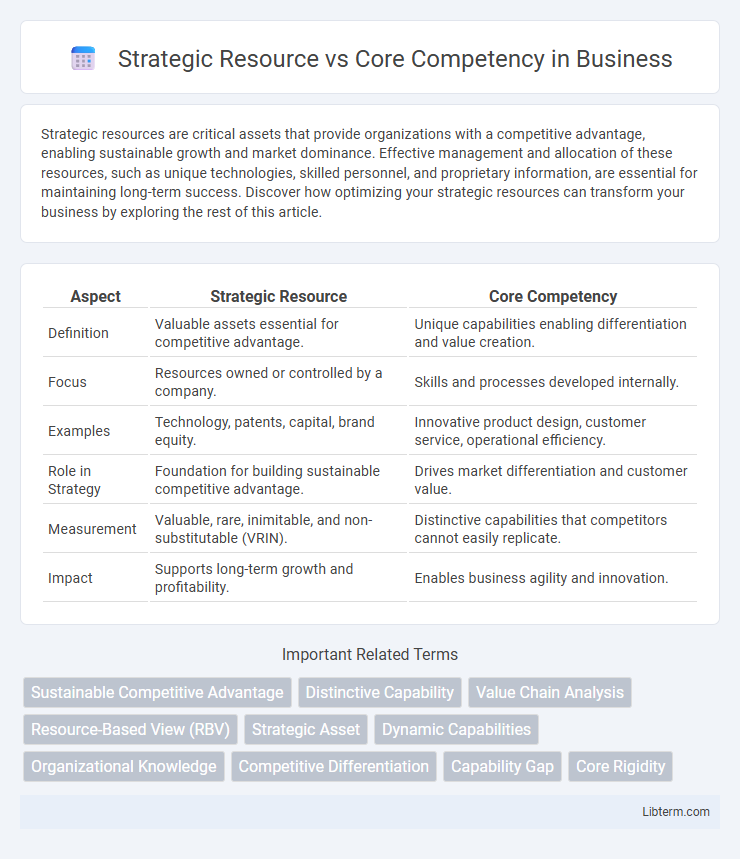Strategic resources are critical assets that provide organizations with a competitive advantage, enabling sustainable growth and market dominance. Effective management and allocation of these resources, such as unique technologies, skilled personnel, and proprietary information, are essential for maintaining long-term success. Discover how optimizing your strategic resources can transform your business by exploring the rest of this article.
Table of Comparison
| Aspect | Strategic Resource | Core Competency |
|---|---|---|
| Definition | Valuable assets essential for competitive advantage. | Unique capabilities enabling differentiation and value creation. |
| Focus | Resources owned or controlled by a company. | Skills and processes developed internally. |
| Examples | Technology, patents, capital, brand equity. | Innovative product design, customer service, operational efficiency. |
| Role in Strategy | Foundation for building sustainable competitive advantage. | Drives market differentiation and customer value. |
| Measurement | Valuable, rare, inimitable, and non-substitutable (VRIN). | Distinctive capabilities that competitors cannot easily replicate. |
| Impact | Supports long-term growth and profitability. | Enables business agility and innovation. |
Understanding Strategic Resources and Core Competencies
Strategic resources are valuable, rare, inimitable, and non-substitutable assets that provide a competitive advantage to an organization. Core competencies refer to the unique capabilities and collective learning within a company that distinguish it from competitors and enable it to deliver customer value effectively. Understanding the interplay between strategic resources and core competencies is essential for sustaining long-term competitive advantage and achieving superior organizational performance.
Defining Strategic Resources: Key Elements
Strategic resources consist of valuable, rare, inimitable, and non-substitutable assets that enable a firm to achieve competitive advantage in the marketplace. Key elements include tangible resources such as proprietary technology, financial capital, and physical assets, along with intangible resources like brand reputation, intellectual property, and unique organizational culture. These resources form the foundation for developing core competencies, which are demonstrated capabilities that integrate multiple strategic resources for superior performance.
What Are Core Competencies? Essential Attributes
Core competencies are unique capabilities that provide a company with competitive advantages, combining collective learning, skills, and technologies. Essential attributes of core competencies include providing access to a wide variety of markets, contributing significantly to customer benefits, and being difficult for competitors to imitate. Unlike strategic resources, which are valuable assets, core competencies integrate multiple resources and expertise to drive sustainable growth and innovation.
The Role of Strategic Resources in Gaining Competitive Advantage
Strategic resources, such as unique technology, valuable patents, and specialized human capital, are critical assets that enable firms to achieve and sustain competitive advantage in dynamic markets. Unlike core competencies, which are the skills and capabilities developed from integrating multiple resources, strategic resources provide the foundational value that competitors find difficult to replicate or substitute. Firms leveraging strategic resources effectively can create barriers to entry and capture superior market position through resource-based advantage theories.
Core Competencies: Driving Sustainable Business Success
Core competencies are unique strengths integral to a company's competitive advantage, enabling the creation of distinctive value and innovation, which drive long-term business sustainability. These capabilities, often rooted in specialized knowledge, technology, or processes, differentiate organizations in dynamic markets and foster customer loyalty. Focusing on core competencies enhances strategic agility and supports continuous growth by aligning resources with key business objectives.
Key Differences Between Strategic Resources and Core Competencies
Strategic resources are assets or capabilities critical to a firm's competitive advantage, encompassing tangible and intangible elements such as technology, brand reputation, and financial strength. Core competencies refer to unique skills and knowledge that enable a company to deliver distinctive value, often involving specialized expertise, innovation, and processes that competitors find hard to replicate. Unlike strategic resources, core competencies are embedded in organizational learning and are the source of sustainable competitive advantage driving strategic resource development.
How to Identify Your Organization’s Strategic Resources
Identifying your organization's strategic resources involves analyzing tangible and intangible assets that provide competitive advantage, such as proprietary technology, specialized human capital, and valuable brand reputation. Conduct a resource audit by evaluating asset rarity, value, inimitability, and organizational support to determine which resources contribute to sustained market differentiation. Focus on resources that directly impact long-term profitability, innovation capabilities, and customer loyalty to distinguish core competencies from general assets.
Developing and Nurturing Core Competencies
Developing and nurturing core competencies involves identifying unique skills and capabilities that provide competitive advantage and are difficult for competitors to imitate. Strategic resources, such as technology, human capital, and organizational processes, must be effectively managed to support and enhance these core competencies. Continuous investment in innovation, employee training, and knowledge management ensures that core competencies evolve and sustain firm performance.
Aligning Strategic Resources and Core Competencies for Growth
Aligning strategic resources with core competencies enables organizations to leverage unique assets for sustainable competitive advantage and accelerated growth. Effective integration focuses on exploiting valuable resources such as technology, talent, and intellectual property that reinforce core capabilities. This alignment drives innovation, market responsiveness, and operational efficiency critical for long-term success.
Case Studies: Successful Application in Leading Businesses
Google's core competency in data analytics serves as a strategic resource that drives innovation and competitive advantage through products like Google Search and Ads. Amazon leverages its strategic resource of advanced logistics capabilities, underpinned by core competencies in supply chain management, to dominate e-commerce and cloud services globally. Toyota applies its core competency in lean manufacturing as a strategic resource to enhance production efficiency and maintain industry leadership in automotive manufacturing.
Strategic Resource Infographic

 libterm.com
libterm.com